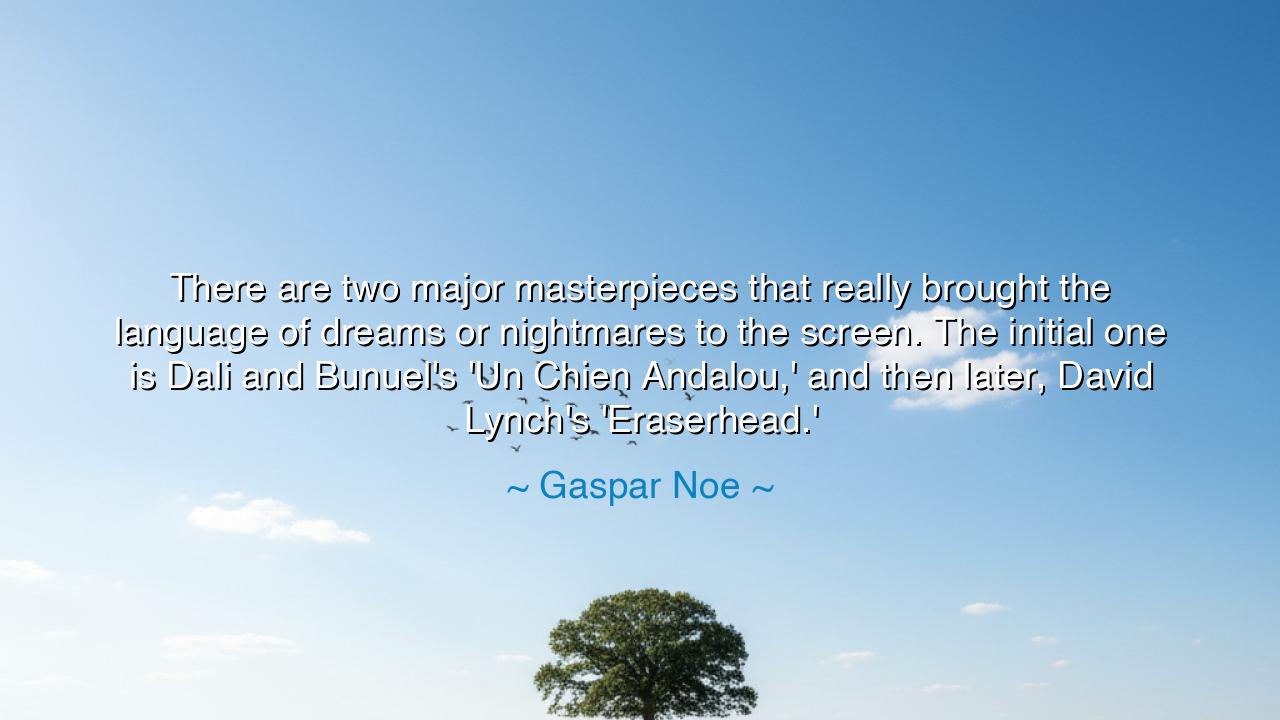
There are two major masterpieces that really brought the language
There are two major masterpieces that really brought the language of dreams or nightmares to the screen. The initial one is Dali and Bunuel's 'Un Chien Andalou,' and then later, David Lynch's 'Eraserhead.'






The words “There are two major masterpieces that really brought the language of dreams or nightmares to the screen. The initial one is Dali and Buñuel's Un Chien Andalou, and then later, David Lynch's Eraserhead” were spoken by Gaspar Noé, a filmmaker known for his raw, surreal, and often unsettling explorations of human consciousness. In this statement, Noé pays tribute to two titanic works of cinema that shattered the boundaries of logic and narrative, ushering audiences into the realm of the subconscious, where reason gives way to raw emotion and vision. His words are not merely a reflection on art—they are a meditation on the power of film to mirror the landscape of the human dream, that twilight place where beauty and terror are inseparable.
When Noé speaks of the “language of dreams or nightmares,” he refers to a mode of expression beyond words, beyond reason—the cinematic language of the soul. In dreams, time bends, logic dissolves, and symbols speak in whispers that only the heart can understand. To translate such a language onto the screen is no small feat. It requires the courage to abandon structure and embrace chaos—to make art not with control, but with surrender. Salvador Dali and Luis Buñuel, in their 1929 collaboration Un Chien Andalou, did precisely this. With its shocking images—a razor slicing an eye, ants crawling from a hand, the moon gliding behind clouds—it did not tell a story so much as it summoned a state of being. It was not meant to be understood; it was meant to be felt. In this way, Dali and Buñuel became the first to wield film as a dreamer wields imagination.
Decades later, David Lynch, with his 1977 film Eraserhead, carried this torch into the modern age. If Un Chien Andalou was the dream, Eraserhead was the nightmare—the dark mirror reflecting the anxieties of a fractured modern world. Lynch’s film whispered not of fantasy, but of fear, of the grotesque beauty that hides in ordinary things. Its industrial landscapes hummed with the sound of dread; its strange infant creature embodied the terror of creation and responsibility. Through it, Lynch captured the emotional logic of nightmares—the way they grip the mind and heart without reason, the way they make the unseen visible. Where Buñuel and Dali broke the walls of reality, Lynch explored what lay behind them.
Gaspar Noé, himself a disciple of such art, recognized in these films the origin of cinematic surrealism, the ancestral voice from which his own vision descends. For him, cinema is not mere storytelling; it is revelation—a descent into the subconscious where the boundaries between beauty and horror dissolve. To speak of dreams and nightmares is to speak of the same source, for both are born from the same well of imagination. The dream soothes; the nightmare confronts. Together, they form the full spectrum of human awareness, and art, when it is true, must speak both languages.
The ancients, too, understood this duality. The Greeks revered Morpheus, god of dreams, and his brother Phobetor, god of nightmares—two faces of the same mystery. The dream was the soul’s journey through shadow and light, its dialogue with the unseen. So too do Dali, Buñuel, and Lynch call us to witness that sacred conversation. Their films remind us that the human mind, in its depths, is vast and ungovernable, a landscape of wonder and terror that must be explored, not tamed.
To watch such films, or to create anything in their spirit, is to surrender control. The artist becomes a vessel through which the subconscious speaks, and the viewer, if willing, becomes a pilgrim in the temple of dream. The experience is unsettling because it reveals what the waking mind hides: desire, fear, guilt, and awe. Yet through this confrontation comes understanding. By facing the nightmare, we reclaim the dream. By exploring the irrational, we touch the essence of truth.
Thus, let this be your lesson, O seeker of meaning: do not fear the chaos within you. For dreams, both bright and dark, are the messengers of the soul. Respect them, as Noé respects the films that dared to bring them to life. When you create—or when you live—let your imagination speak without censorship, your heart without restraint. For the dream is the purest mirror of the self, and to give it voice, as Dali, Buñuel, and Lynch did, is to draw nearer to the divine mystery that lives in all human beings.
And so, when Gaspar Noé calls these films the “masterpieces that brought the language of dreams or nightmares to the screen,” he is offering a sacred truth: that art’s highest calling is not to explain reality, but to reveal what lies beyond it—to open the door to the infinite world within. For in dreams, and in nightmares alike, we remember what it truly means to be alive.






AAdministratorAdministrator
Welcome, honored guests. Please leave a comment, we will respond soon